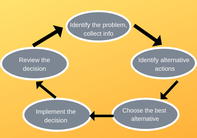Since farming is a business and money and time is at stake, making a decision should not be improvised or be done over-hasty. Farmers should take the farm’s resources into account.

Resources can include staff (labour), money, time, water availability and market requirements. All these resources should be integrated into the farmer’s objective - to make a profit.
Other farming objectives that can play a role in the decision-making on a farm are:
Increase production and sales
Reducing costs
Avoiding risks and debt
To achieve a good standard of living standard and to care for the family
Ensuring that the farm survives in the long term
The Decision-making Process
The decision-making process on a farm (and, in fact, in any facet of life) can be divided into five steps.
Identify the problem.
There might be a problem such as poor yield in your crops, but what is the source of the problem? Are you using poor quality seeds? Do you plant too early so seedlings are damaged by frost? Is your soil too poor?
A problem can also be an opportunity to grow. Start by collecting information. For example, find out how neighbouring farms are performing - do they use compost or fertiliser, when do they plant, how much do they irrigate and so on.
Investigate alternative solutions or actions.
After identifying the problems and the real sources of the problems, alternative solutions should be investigated. Can you change your time of planting, add compost or use better seed cultivars? This should be tested to see what the impact will be - earlier planting or enriching the soil with compost before planting could lead to better growth, which could result in an increase in profits.
Choose the best alternative.
Which of the alternatives are more likely to improve farm performance? Compare the advantages and disadvantages of each alternative in terms of cost, how much labour will be needed, timing and risks. (e.g. compost can be expensive to buy and transport but you have cattle so you could make your own, but this can take longer.)
Implement the decision.
When implementing the best alternative, put it into action. The required resources (e.g. labour, irrigation, fertiliser) should be organised, which implies action. The decision maker should accept responsibility for making it happen. (e.g. appoint someone to collect manure and start making compost, select a time to apply compost and plan for enough labour to apply compost at the right time.)
Evaluate the result.
Monitor the progress to see whether the objectives are achieved. Recordkeeping in farming is essential to keep track of changes and improvements. Note down all changes made and any results that were achieved. (e.g. How much compost was applied, what was the difference in yield compared to the plots where you did not apply compost?)